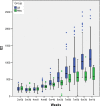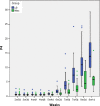Endogenous progesterone levels could predict reproductive outcome in frozen embryo replacement cycles supplemented with synthetic progestogens: A retrospective cohort study
- PMID: 30655726
- PMCID: PMC6332737
- DOI: 10.1002/rmb2.12254
Endogenous progesterone levels could predict reproductive outcome in frozen embryo replacement cycles supplemented with synthetic progestogens: A retrospective cohort study
Abstract
Purpose: A retrospective, cohort study was conducted between 2009 and 2017 in a private infertility center to determine the predictive value of endogenous estrogen (E2) and progesterone (P4) levels in hormone-replacement frozen embryo replacement (FER) treatment cycles.
Methods: A total of 120 consecutive, infertile patients who became pregnant after FER cycles were analyzed (age: 37.4 ± 4.4 years). Electively vitrified blastocysts were created during natural cycle IVF or mild ovarian stimulation treatments and subsequently transferred through delayed vitrified-thawed blastocyst transfer cycles supplemented with estrogens and a combination of synthetic progestogens. Serum E2 and progesterone P4 levels were intensively monitored every five days (from the day after embryo transfer until 9w1d of pregnancy) and compared among patients with a subsequent live birth (n = 76) or first-trimester pregnancy loss (n = 44).
Results: Endogenous placental activity started as early as 5-6th pregnancy week differing significantly according to pregnancy outcome. For P4, the exponential rise from 6w2d onwards allowed distinguishing between failing and successful conceptions. For P4, lower quartiles of the live birth group did not intersect with upper quartiles of the miscarriage group.
Conclusions: Innovative FER protocols incorporating synthetic progestogens allow the correct measurement of endogenous placental activity and could help to monitor early first-trimester ART pregnancies.
Keywords: blastocyst transfer; dydrogesterone; fertilization in vitro; placental progesterone; single embryo transfer.
Figures
Similar articles
-
Individualised luteal phase support in artificially prepared frozen embryo transfer cycles based on serum progesterone levels: a prospective cohort study.Hum Reprod. 2021 May 17;36(6):1552-1560. doi: 10.1093/humrep/deab031. Hum Reprod. 2021. PMID: 33686413
-
Dydrogesterone and 20α-dihydrodydrogesterone plasma levels on day of embryo transfer and clinical outcome in an anovulatory programmed frozen-thawed embryo transfer cycle: a prospective cohort study.Hum Reprod. 2022 May 30;37(6):1183-1193. doi: 10.1093/humrep/deac045. Hum Reprod. 2022. PMID: 35323905
-
The impact of luteal serum progesterone levels on live birth rates-a prospective study of 602 IVF/ICSI cycles.Hum Reprod. 2018 Aug 1;33(8):1506-1516. doi: 10.1093/humrep/dey226. Hum Reprod. 2018. PMID: 29955789
-
What is the 'ideal' duration of progesterone supplementation before the transfer of cryopreserved-thawed embryos in estrogen/progesterone replacement protocols?Hum Reprod. 2005 May;20(5):1127-34. doi: 10.1093/humrep/deh762. Epub 2005 Feb 3. Hum Reprod. 2005. PMID: 15695314 Review.
-
Guidelines for the number of embryos to transfer following in vitro fertilization No. 182, September 2006.Int J Gynaecol Obstet. 2008 Aug;102(2):203-16. doi: 10.1016/j.ijgo.2008.01.007. Int J Gynaecol Obstet. 2008. PMID: 18773532 Review.
Cited by
-
Association of Early-to-Mid-Luteal Serum Estradiol Levels with the Outcomes of Hormone Replacement Therapy-Frozen Embryo Transfer: A Systematic Review and Meta-Analysis.Reprod Sci. 2025 Aug 13. doi: 10.1007/s43032-025-01952-1. Online ahead of print. Reprod Sci. 2025. PMID: 40802132 Review.
-
Rectal progesterone administration secures a high ongoing pregnancy rate in a personalized Hormone Replacement Therapy Frozen Embryo Transfer (HRT-FET) protocol: a prospective interventional study.Hum Reprod. 2023 Nov 2;38(11):2221-2229. doi: 10.1093/humrep/dead185. Hum Reprod. 2023. PMID: 37759346 Free PMC article.
-
Serum Progesterone Profile Across the Mid and Late Luteal Phase in Artificial Cycles Is Associated With Pregnancy Outcome.Front Endocrinol (Lausanne). 2021 Jun 10;12:665717. doi: 10.3389/fendo.2021.665717. eCollection 2021. Front Endocrinol (Lausanne). 2021. PMID: 34177806 Free PMC article. Clinical Trial.
-
Serum progesterone concentration on pregnancy test day might predict ongoing pregnancy after controlled ovarian stimulation and fresh embryo transfer.Front Endocrinol (Lausanne). 2023 Jun 26;14:1191648. doi: 10.3389/fendo.2023.1191648. eCollection 2023. Front Endocrinol (Lausanne). 2023. PMID: 37455896 Free PMC article.
-
Role of Dydrogesterone for Luteal Phase Support in Assisted Reproduction.Reprod Sci. 2024 Jan;31(1):17-29. doi: 10.1007/s43032-023-01302-z. Epub 2023 Jul 24. Reprod Sci. 2024. PMID: 37488405 Review.
References
-
- Mackens S, Santos‐Ribeiro S, van de Vijver A, et al. Frozen embryo transfer: a review on the optimal endometrial preparation and timing. Hum Reprod. 2017;32(11):2234‐2242. - PubMed
-
- Lutjen P, Trounson A, Leeton J, Findlay J, Wood C, Renou P. The establishment and maintenance of pregnancy using in vitro fertilization and embryo donation in a patient with primary ovarian failure. Nature. 1984;307(5947):174‐175. - PubMed
-
- Glujovsky D, Pesce R, Fiszbajn G, Sueldo C, Hart RJ, Ciapponi A. Endometrial preparation for women undergoing embryo transfer with frozen embryos or embryos derived from donor oocytes. Cochrane Database Syst Rev. 2010;20(1):CD006359. - PubMed
LinkOut - more resources
Full Text Sources



